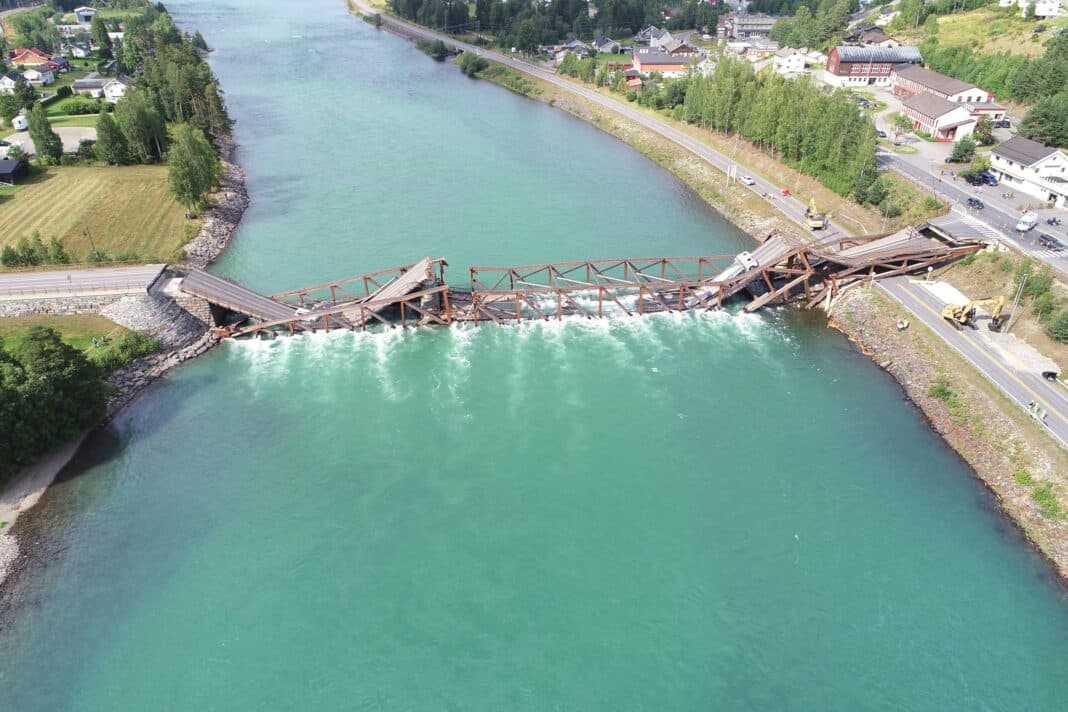An official investigation into the collapse of the 70-metre span Tretten Bridge in Norway “has shown that inadequate caution was exercised in planning, designing, inspecting and approving the bridge.”
The collapse of the timber-and-steel bridge made global headlines, leading the Norwegian Public Roads Administration (NPRA) to close fourteen timber bridges across the country. To date, nine of these bridges remain closed, with plans now afoot to rebuild four to address structural concerns.
Published by the Norwegian Safety Investigation Authority (NSIA) earlier this month, it the report states that “the choice of material and a strong focus on aesthetics contributed to the structure not being robust,” adding that an accelerated construction period, problems with the span lengths, and the reuse of existing foundation contributed to the collapse.
The glulam-and-steel truss bridge, which opened in 2012, was commissioned by the NPRA, which manages more than 19,000 bridges across the country. It was designed by the Norwegian architecture studio Plan Arkitekter and engineering firm Norconsult, with NSIA critical of parties given the risk factors concerning its “unconventional design.”
It follows an earlier report, also published by the NSIA, which stated that the bridge collapse was most likely caused by block shear failure—a type of fracture—in one of its timber diagonal members, which weakens over time.
Wood Central understands that the Tretten Bridge was designed while building regulations were transitioning from a national system to European codes – allowing the bridge to be constructed according to older national standards and not Eurocodes, with the older standards allowing for construction that did not account for block shear failure.
In the report, the NSIA said, “All the involved parties can be criticised for selecting and accepting regulations that proved to have a serious shortcoming (block shear failure).” The report also dealt with investigations of Tretten Bridge carried out after the Perkolo Bridge collapsed in 2016, finding that despite “serious faults” being identified in the bridge, “little action was taken by the Norwegian roads authority.”
“This represents a system failure in the NPRA, showing a lack of knowledge about block shear failure, as well as shortcomings in the bridge management system and risk management,” the report continues. The NSIA believes that Tretten Bridge should have been “either immediately closed or traffic restrictions imposed in 2016 when finding over-utilisation about block shear in several of the bridge’s connections.”
In the aftermath, the NSIA has tabled six safety recommendations that provide lessons for road authorities worldwide. These include reviewing the process for regulating and approving road-related structures and their materials in Norway and clarifying building regulations.
Before the collapse, Tretten Bridge was 148 metres long and 10.5 metres wide, with a main span of 70 metres. A report produced by Plan Arkitekter and Norconsult in 2013 gave the bridge a life expectancy of 100 years.
At the time, NSIA stated, “As far as the Accident Investigation Board is aware, there are no wooden and steel truss bridges in the world that are comparable to Tretten Bridge.”
“The bridge was special in span length and asymmetry, with trusses in the same direction and a combination of wood and steel.”
In response to the report, Plan Arkitetker, responsible for the design of several wooden bridges for the NPRA, told Dezeen:
“If you read the conclusion from NSIA, you will see that the collapse of the Tretten Bridge was caused by deficient regulations (the previous national code) for building timber structures at the time of planning/construction,” according to Yngve Aartun, a partner at Plan Arkitetker.
“When new regulations (Eurocode) in 2016 revealed a few critical weak joints, nothing was done to improve these joints,” he said, adding that “the bridge had a normal schedule for engineering and construction. The aesthetics were decided by structural and constructional considerations and not a governing topic to decide the structure in the planning process.”
According to NPRA director general Ingrid Dahl Hovland, the Norwegian government agency is “well underway” with measures to address bridge safety.
“We are in the process of signing off on the first measures,” she said. “We want to ensure that any nuances between the safety recommendations from NSIA and the package of measures are captured. This work has top priority.”







